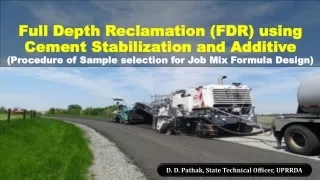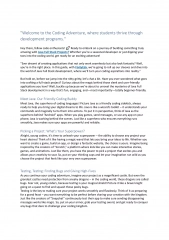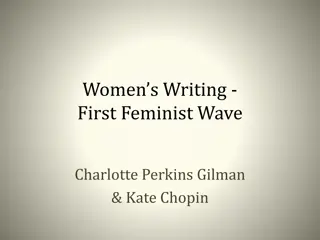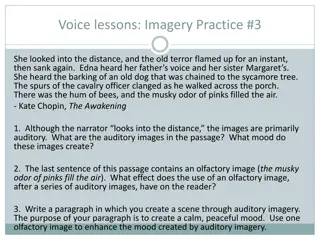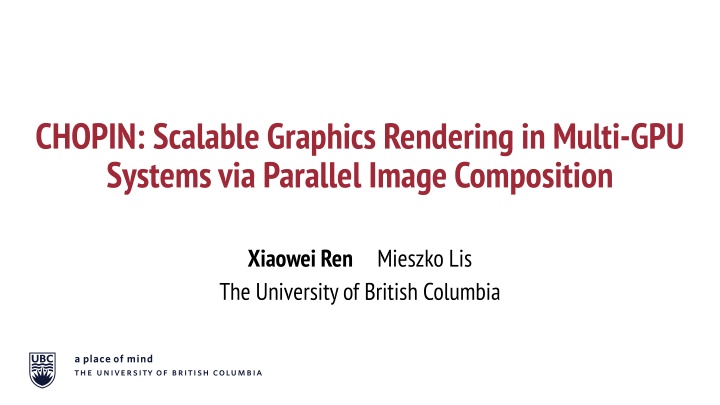
Optimizing Multi-GPU Graphics Rendering Through Parallel Image Composition
Explore how CHOPIN enhances graphics rendering in multi-GPU systems by leveraging parallel image composition to eliminate bottlenecks and improve performance by up to 56%. Understand the significance of inter-GPU synchronization in generating high-quality images and overcoming limitations such as redundant computing and sequential communication. Delve into the complexities of the graphics pipeline, bottleneck challenges, and synchronization methods for efficient multi-GPU rendering.
Download Presentation

Please find below an Image/Link to download the presentation.
The content on the website is provided AS IS for your information and personal use only. It may not be sold, licensed, or shared on other websites without obtaining consent from the author. If you encounter any issues during the download, it is possible that the publisher has removed the file from their server.
You are allowed to download the files provided on this website for personal or commercial use, subject to the condition that they are used lawfully. All files are the property of their respective owners.
The content on the website is provided AS IS for your information and personal use only. It may not be sold, licensed, or shared on other websites without obtaining consent from the author.
E N D
Presentation Transcript
CHOPIN: Scalable Graphics Rendering in Multi-GPU Systems via Parallel Image Composition Xiaowei Ren Mieszko Lis The University of British Columbia
Coming Up Extend performance scaling of graphics rendering in the latest multi-GPUs Prior bottlenecks: redundant computing and sequential inter-GPU communication Our work: Insight: eliminating prior bottlenecks by leveraging parallel image composition Outperform the best prior scheme by up to 56% (25% gmean) 2
Graphics Pipeline 2D Screen Space 3D Object Space Fragments Pixels y v0 v0 v3 v3 v1 v2 v1 v2 x Geometry Processing Fragment Processing Rasterization Need multi-GPU solutions to meet increasing performance requirements 3 Chas Boyd. The DirectX 11 Compute Shader. In SIGGRAPH 2008.
Graphics Pipeline 3D Object 2D Screen y Fragments Pixels v0 GPU 0 v0 v1 v2 v1 v2 v0 x v3 y v1 v2 v0 v0 v3 v3 GPU 1 v1 v1 x Inter-GPU synchronization is necessary for the final image generation Inter-GPU synchronization cannot break the primitive depth order 4
Bottleneck: Primitive Duplication assign screen regions to different GPUs limited by inter-GPU links (e.g., SLI, CrossFire), duplicate all primitives in each GPU GPU2 GPU3 filter out primitives and fragments of other GPUs GPU0 GPU1 simple, but limited by redundant computing 2D Screen 2 8GPUs, % of Geo Process cycles 55% 75% Modern inter-GPU links (e.g., NVLink, NVSwitch) enable high-performance inter-GPU synchronization 5 NVIDIA. SLI Best Practices. 2011.
Synchronization in Multi-GPU Rendering sort-first Primitives sort-last sort-middle Primitives Primitives Sync. G G G G CHOPIN G G R&F R&F Sync. Sync. R&F R&F R&F R&F Display Display Display exchange raw-primitive exchange screen-primitive exchange fragments/pixels G: Geometry Processing, R: Rasterization, F: Fragment Processing 6 Molnar et al. A Sorting Classification of Parallel Rendering. In CG&A 1994.
Bottleneck: Sequential Inter-GPU Sync. GPUpd: a scheme of sort-first multi-GPU rendering D P P P P G G G G R&F R&F R&F R&F evenly distribute primitives to GPUs requires sequential primitive distribution among GPUs GPU0 GPU1 GPU2 GPU3 D D D P: Projection D: Distribution G: Geometry Processing R: Rasterization F: Fragment Processing sequential inter-GPU communication becomes critical bottleneck with more GPUs 2 8GPUs, % of stage D cycles 6% 29% 7 Kim et al. GPUpd: A Fast and Scalable Multi-GPU Architecture using Cooperative Projection and Distribution. In Micro 2017.
Parallelism of Image Composition Opaque Sub-image Composition: Semi-transparent Sub-image Composition: 8
Parallelism of Image Composition Opaque Sub-image Composition: occlude pixels that are further to camera GPU1 GPU2 GPU0 GPU1 GPU2 GPU1 GPU0 GPU2 GPU0 C AB C C C A A A B B B C over B over A step 1 step 2 opaque sub-images can be composed out-of-order 9
Parallelism of Image Composition Semi-transparent Sub-image Composition: blending two pixels GPU1 GPU2 GPU0 GPU1 GPU2 GPU1 GPU0 GPU2 GPU0 C AB C C C A A A B B B C over B over A step 1 step 2 semi-transparent composition is not commutative, but it s associative start to compose adjacent sub-images once they are ready 10 Bethel et al. High Performance Visualization: Enabling Extreme-Scale Scientific Insight (Chapter 5). In CRC Press 2012.
Parallelism of Image Composition Opaque Sub-image Composition: Simply occlude pixels that are further to camera can be composed out-of-order Semi-transparent Sub-image Composition: blending two pixels, not commutative, but it s associative Start to compose adjacent sub-images once they are ready 11
Leveraging Parallel Image Composition Insight: sequential primitive distribution parallel image composition GPU0 GPU1 GPU2 GPU3 P P P P D G G G G R&F R&F R&F R&F GPUpd D send draws to different GPUs, so no redundant computing D D GPU0 GPU1 GPU2 GPU3 comp. comp. comp. comp. G G G G R&F R&F R&F R&F CHOPIN reduced cycles compose sub-images in parallel P: Projection D: Distribution G: Geometry Processing R: Rasterization F: Fragment Processing 12
Draw Command Scheduler Distribute draw commands to GPUs with Round Robin scheduling Draw4 Draw5 Draw6 Draw7 Draw0 Draw1 Draw2 Draw3 GPU 0 GPU 1 GPU 2 GPU 3 execution time of draw commands vary significantly simple, but can create load imbalance very easily 13
Draw Command Scheduler optimal load balancing requires ideal execution time estimation 2D Screen Space y 3D Object Space Fragments Pixels v0 v0 v3 v3 v2 v1 v2 v1 x Geometry Processing Fragment Processing Rasterization Heuristic: more primitives waiting at geometry processing indicates bigger remaining workload of the graphics pipeline Scheduler: schedule each draw to the GPU that has the smallest number of remaining primitives in geometry processing 14
Image Composition Scheduler running done done done GPU 0 GPU 1 GPU 2 GPU 3 congestion scheduler table records GPU execution status e.g., running? busy composing? Only start inter-GPU communication while two GPUs are ready and available 15
Overall Performance 1.6 Normalized Speedup 8-GPU system, 8 real-world game traces 1.2 0.8 25% faster than the best prior solution 0.4 within 5% of the idealized system with image composition 0.0 Duplication GPUpd Ideal-GPUpd Ideal-CHOPIN CHOPIN 16
Scaling to Modern and Future Games Crysis Remastered (released in Sept. 2020) average number of triangles: 12 million / frame average primitive processing time: 11.57ms / frame average fragment processing time: 11.11ms / frame bigger number of triangles longer primitive processing time more redundant computing larger sequential bottleneck modern and future games favor schemes of parallel image composition 17
Summary Prior multi-GPU rendering mechanisms are not scalable due to redundant computing and sequential inter-GPU communication Leveraging parallelism of image composition can eliminate the bottlenecks of prior work and extend performance scaling Modern and future games favor schemes of parallel image composition 18
Thank you Contact me: xiaowei@ece.ubc.ca This presentation and recording belong to the authors. No distribution is allowed without the authors' permission. 19

